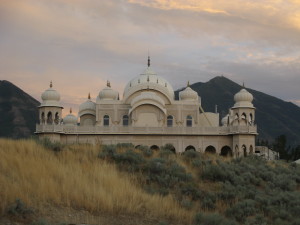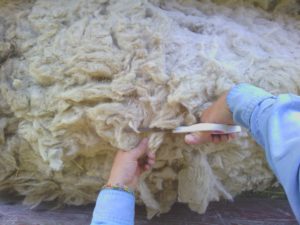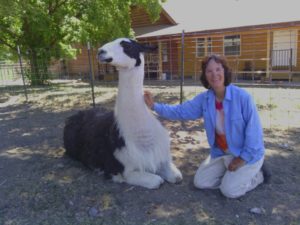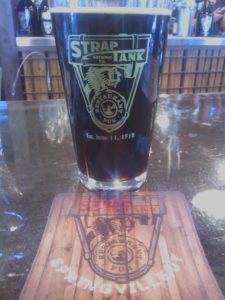My twenty-third farm was the Krishna Community in Spanish Fork, Utah.
The Farm
The farmers are Vai and Caru. Vai is originally from England, and Caru is from Pennsylvania. Vai met Caru when she was traveling in Singapore in the 1960s. She walked into a cafe and he pulled out a chair for her. She never planned to get married or have kids but thought, ‘I could marry him.’ Having no money and wanting to move on to Australia, she sailed across on a commercial ship. The ship landed in a place where only the male sailors could stay. Vai had to take the only bus out of town that day, which went to Darwin. In Darwin, she ran into Caru again. She asked him if he’d like to go to Cairns with her. They’ve been together ever since. While in Australia, they met some missionaries of the Krishna movement and liked what they heard. They moved to Los Angles, where Caru had a radio station to talk about Krishna. They tired of LA and came to Utah in 1982.They bought a few acres of land on a hill in Spanish Fork that had a radio station on it. Caru used it to broadcast his Krishna talks. Vai bought some llamas because they were fashionable. Ironically, this land on the hill was originally owned by the Mormons who were going to build a church. Then it was sold to the Catholics who were also going to build a church. Caru and Vai wanted to buy a neighboring piece of property, so they could build a temple on it, but they didn’t have the $8,000 it cost. Then a man appeared wanting to buy a baby llama. “How much is your little llama?” he asked. “Eight thousand dollars,” Vai responded. They now had that parcel of land. Later, they needed excavating. A man volunteered his father, a professional excavator. Volunteers and cash came when needed, and the temple got built. Vai commented that a higher power was watching over them while they were on this path.
My Experience
“She’s had a good life. That’s why she doesn’t want to leave her body,” Vai reflected.
There was a dying llama next to the front door. She’s been on her side not eating for over a week. “When an animal dies it is the end of rebirth,” Vai told me. “So, it is a joyous time for this llama who is leaving her body for the last time.” Vai had me fill a bowl with water and offer it to the llama. She raised her head and drank, obviously appreciative. Vai guessed that the llama would be dead in a day or two.
Plants give blessings when you water them,” Pada.
I was given the responsibility to water the new vegetable garden. It was meditative; I slowly walked down the rows letting the sprinkler sprinkle each plant for ten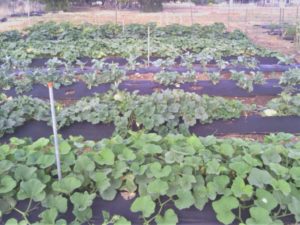 seconds. “The souls of plants are in their roots,” Pada, one of the Indian priests who worked at the temple, told me. Hopefully their souls were getting enough water. The area is hot and dry generally, but this was another record-setting hot summer. There was a lot of worry that the plants weren’t growing well in the heat.
seconds. “The souls of plants are in their roots,” Pada, one of the Indian priests who worked at the temple, told me. Hopefully their souls were getting enough water. The area is hot and dry generally, but this was another record-setting hot summer. There was a lot of worry that the plants weren’t growing well in the heat.
The llama was still alive a few days later. She would raise her head for water when I walked by. “Her legs are always moving when she sleeps,” Vai commented. “She must be dreaming that she’s running.” I wondered what the Hare Krishna views were on euthanasia. Would the llama be put down? It was obviously time. Or would she be left to die on her own? I fell asleep wondering about this. When I awoke, I discovered a vet had come by and the llama had now left her body. Four of us carried the llama to a large hole. Vai covered the llama’s face with a pillow to keep it clean, and we placed the body facing east. Then we filled in the hole with dirt. I at least felt joyous. The llama was out of her misery.
Spanish Fork is ninety percent Mormon, so the temple is a novelty. It sits on a scenic hill with the Wasatch Mountains behind it. The grounds feature a leafy pond with statues and a menagerie of animals: a white peacock with a delicate tiara of feathers above his head, a little parrot that whistles at you, three holy cows, and a flock of pack llamas that can be rented out. Inside the temple on the ground floor is a restaurant with lunch and dinner buffets and a gift shop with anything a Krishna follower might need for a spiritual practice. On the top floor is a large open space with a shrine to Krishna against one wall. Two families had been brought over from India to work at the temple. The men were priests, and the women did the cooking for the buffets. The buffets were an attraction to help draw in tourists who might give a donation or spend some money in the gift shop.
Hare Krishna is a branch of Hinduism that started in the 16th century. It reveres Krishna as the highest form of God. Hare Krishnas are vegetarian because they believe that animals are the children of Krishna and have a soul. To eat one would be an insult to God. They also believe in karma and reincarnation. One’s past actions influence the future and the body in which they will be reincarnated, unless they have finally been freed from the cycle of life and death. Living in harmony with nature’s laws brings good karma. The most familiar ritual of Hare Krishnas is the recitation of their mantra.
Hare Krishna, Hare Krishna, Krishna Krishna, Hare Hare
Hare Rama, Hare Rama, Rama Rama, Hare Hare
The mantra is a meditation that awakens the soul so it can connect to God. The words are names of Lord Vishnu, the God who preserves and protects the universe, and His earthly incarnations, Krishna and Rama.
One interpretation of the mantra is
Hare-“He who removes illusion”
Krishna-“He who is all-attractive”
Rama-”He who is the source of all pleasure.”
Prayer beads help count out the rounds. One round is saying the mantra 108 times. Sixteen rounds, which takes two hours, is the standard chant.
“It’s like living in a hair dryer,” said Vai as we were walking through a hot wind. She heard on the radio that this was the hottest year on record world-wide (2016)
I got fired from my job watering the vegetable garden. I was doing my best to keep the vegetables well-watered in the dry heat and had followed Pada’s instructions. One evening when I went to water, I found three people in the garden watering. Pada felt I hadn’t been watering the plants enough and they were wilting. Maybe they were needing some special plant blessings too.
The focus of my five-hour workdays was cleaning up the grounds. I did a lot of work around the pond, cutting back plants and pulling up invasive weeds, all while 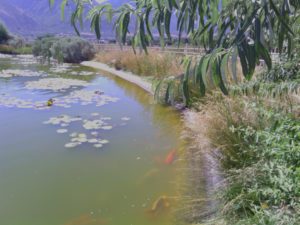 trying not to slip and fall in. There was also some weeding and clearing out of trash. The yard work was not that interesting. I did get a little time with the llamas. I learned how to harness them and had a day to practice shearing them with scissors. (No blood was spilled.) While I worked outside, occasional busloads of young Hare Krishnas arrived to tour the temple and have the buffet lunch.
trying not to slip and fall in. There was also some weeding and clearing out of trash. The yard work was not that interesting. I did get a little time with the llamas. I learned how to harness them and had a day to practice shearing them with scissors. (No blood was spilled.) While I worked outside, occasional busloads of young Hare Krishnas arrived to tour the temple and have the buffet lunch.
I was excited about the daily yoga classes. Pada was the instructor, and the clientele was lithe 20-somethings. That should have been a clue. Our first pose was putting our hands on the floor and raising our body up off the floor. I watched in amazement that this was humanly possible. Most of the class was well beyond what I’ve ever done in yoga. When I mentioned this to Pada later, he exclaimed, “You’re too old!” but also said that it took him three years to be able to lift himself off the ground.
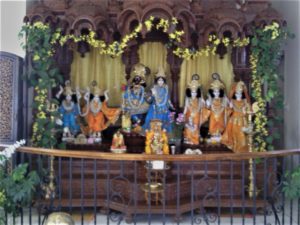 On Sunday evenings the temple has a program for ‘seekers.’ On the two Sundays I was there, about thirty young people turned out to hear a lesson on Krishna Conscience, do some chanting, and indulge in a feast. (The typical dinner buffet with a few new things added.) They sat quietly, listening to the basics of the religion. Then they were forced to their feet to move with the music and rhythm of the mantra. Hare Krishna, Hare Krishna, Krishna Krishna, Hare Hare… That broke the ice. The ‘seekers’ bought out the mantra bracelets and were ready for their feast. Did any of these people return on another Sunday evening for this program, I wondered.
On Sunday evenings the temple has a program for ‘seekers.’ On the two Sundays I was there, about thirty young people turned out to hear a lesson on Krishna Conscience, do some chanting, and indulge in a feast. (The typical dinner buffet with a few new things added.) They sat quietly, listening to the basics of the religion. Then they were forced to their feet to move with the music and rhythm of the mantra. Hare Krishna, Hare Krishna, Krishna Krishna, Hare Hare… That broke the ice. The ‘seekers’ bought out the mantra bracelets and were ready for their feast. Did any of these people return on another Sunday evening for this program, I wondered.
Towards the end of my stay, I had a palm reading from one of the priests. He had some good things to say. The bowl in the center of my hand equals wealth. The long line up the center equals a good education. The strong thumb ‘bump’ is Venus and it’s a good thing. The thin heart line means I didn’t get the love I was supposed to as a child. My parents ignored me. (Really?!) Continuing to look at my palm, he said I’m kind and quiet. I want to do service for others. I’m careful with money and think things through carefully. (So far this sounds pretty true of me.) I’m a hard worker which people appreciate. I’m creative. (I sure wish I was.) I was supposed to have gotten married at around twenty-five to thirty years old to one good guy and have one boy and one girl. I will have good luck because the moon line diverges down-only one in a thousand palms have that, he said. However, the small hole between my index and middle fingers means Saturn is at my back. If Saturn is allowed to the front something bad will happen. I needed to say Hare and clap three times every day and fast for three Saturdays to keep Saturn away. His final comments were that I’d live to between seventy and eighty years old and die a peaceful death. (That’s only ten to twenty more years!) My students will always remember me. (Ahh!) And I’m strong, which is what got me through my childhood with inattentive parents. (I’m going to have a talk with them about this.)
On my handful of days off I explored the area. It was easy to find little hikes in the surrounding mountains. Timpanogos Cave National Monument was also a short drive away. Another good find was the Springville Art Museum which is the oldest museum in Utah and a good place to go for an afternoon when it’s over one hundred degrees out. The highlight for me was the Communist Russia collection. The paintings were large, dramatic and on a topic I understand. A record of history. I finished my museum day in my preferred way-sitting at a brewpub (Strap Tank Brewing) drinking a cold locally brewed beer. Utah isn’t completely dry.

